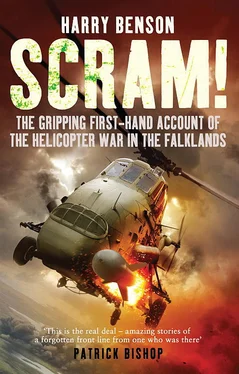Eleven days after setting off from Portsmouth, the first few British ships arrived off the coast of Ascension Island. Having tasked his flight to get on with their contribution to the cross-decking operation, Jack Lomas went ashore to try to track down spare batteries for his Wessex. Landing at Wideawake airfield, he was delighted to see 845 Squadron’s Mobile Air Ops Team (MAOT), led by Lieutenant Brad Reynoldson, marching up and down the huge dispersal area amongst a mass of loads with large green A43 radios strapped to their backs and hooking-up loads. Inbound helicopter crews called up ‘helicom’, on the radio frequency 258.8 megahertz, whereupon Reynoldson and his team would tell them which load needing taking to which ship. ‘MAOT’s running the place. Everything’s going to be fine!’ thought Lomas.
For Sea King and Wessex helicopter crews alike, the biggest problem during cross-decking was finding the destination ship amongst the widely scattered fleet. Armed with a list of ships’ names and the daily changing alphanumeric codes, the pilot would see, for example, that ‘Hotel Three Alpha One’ was the landing ship RFA Sir Galahad . With six identical-looking ships of this type to choose from, and all ships’ names painted over for security, crews resorted to the use of blackboards in the back of the helicopter. Coming to a hover alongside the flight deck, the crewman would hold up the board, ‘Are you Sir Galahad ?’ – a question which invariably prompted a burst of laughter between pilot and crewman. The more serious reply from the flight deck would either be a thumbs-up or a frantic pointing at another nearby ship. Aircrew recognition of RN and RFA ships was already generally excellent. After two hours of load-lifting, crews had worked out where pretty well all the ships were parked.
As well as reorganising stores, the stop at Ascension was an opportunity to reorganise the helicopters. Five of the original junglie Sea Kings remained on Hermes , freeing up more space for Sea Harrier operations. This group included four night-flying Sea Kings.
During the journey south, the cockpits of these four aircraft had to be specially adapted by the squadron engineers so they could be flown with the night vision goggles. The dim red lighting that normally lit the Sea King’s cockpit instruments at night-time would look like dazzling bright sunshine when viewed through the ultra-sensitive goggles. The other four Sea Kings from Hermes were spread between the roll-on, roll-off ferry MV Elk and the P&O cruise liner Canberra . The new arrival from Ascension replaced Mike Crabtree’s two Wessex on HMS Intrepid , which then made their way to the fuel ship RFA Tidepool . Bill Pollock and Simon Thornewill swapped ships so that Pollock could take charge of the special forces night-flying programme from Hermes , and Thornewill, as squadron commanding officer, could liaise with the landing force commanders on Fearless .
Just two days after arriving at Ascension, the carrier group led by HMS Hermes departed south, leaving behind the amphibious group to continue cross-decking and preparing for the eventual landings. The amphibious ships and landing forces weren’t to set off until the naval battle was won.
On board RFA Resource , news of the two Wessex crashes on South Georgia was beginning to filter through via the BBC World Service. ‘Fuck me,’ said Jack Lomas. ‘Thank God Tiddles and his boys didn’t get themselves killed. But two Wessex lost. What a start!’
The following day the atmosphere became decidedly sombre with news that one of the Sea Kings on Hermes had flown into the sea at dusk, killing Petty Officer Aircrewman Kevin ‘Ben’ Casey, the first British fatality of war. As if it were needed after the fiasco on Fortuna, the tragic accident was an unpleasant reminder that conditions in the South Atlantic would pose every bit as much of a threat to aircrew as direct action by the Argentine enemy.
As the fleet sailed further south, they left behind the balmy tropical weather of Ascension and entered the wildly changing conditions of the South Atlantic. On some days the sea would be completely flat calm and the surface almost oily. On others, the wind would whip up heavy seas making conditions for take-off and landing terrible. Often visibility was appalling. Finding ships out in the fleet in such weather, and getting back safely, required skill, ingenuity, and a healthy dose of self-preservation.
Without radar to guide, Wessex 5 crews mostly relied on a method of navigation called ‘dead reckoning’. It didn’t matter exactly where the aircraft was over the sea. What mattered was where the aircraft was in relation to each ship. Dead reckoning meant applying a mental combination of wind and ship direction. The big assumption of course was that the ship’s heading didn’t change. Hence there was always a need to add a large margin for error. All naval aircrew have experienced the unnerving situation of returning to where ‘mother’ should be only to find a vast expanse of sea and no sign of a ship.
The only navigation aid for the Wessex crew was a direction-finding needle on the cockpit panel that swung left or right in response to a radio signal, should the ship be generous enough to use its radio. But with radio silence the norm in the fleet, relying on wits and caution was usually the best strategy for avoiding a cold swim. In especially poor visibility, pilots would deliberately offset the return journey in order to cross a mile or two behind the ship and find the wake. It was then a simple matter of flying up the wake and hoping you then arrived at the right ship.
Along the way, the floating bomb that was RFA Resource regularly transferred ammunition to other ships. Some of this was done by ‘replenishment at sea’, an impressive manoeuvre whereby both ships would sail close alongside one another. Lines would be shot from one ship to the other, followed by heavier lines. Stores could then be hauled across by lines of sailors while the ship transferred fuel by hose suspended from a separate line. The two Wessex helicopters were used extensively to assist in the ammunition transfer by underslung load. However, the containers used to hold the 4.5-inch shells for ships’ guns were in limited supply. Under threat of attack during action stations, some of these boxes were simply despatched off the back of the flight deck, making the shortage even worse.
On board Hermes , the 846 Squadron Sea King detachment now had seven sets of second- and third-generation night vision goggles. To work properly, the goggles needed a minimum level of light from the moon or stars, so they couldn’t be used in the pitch-blackness of heavy cloud cover. In most weather conditions, the goggles enabled the pilots to fly their aircraft visually, almost as if it were daylight, albeit in monochromatic green. However, it wasn’t quite as easy as flying in daylight. The image presented was two-dimensional, not allowing any perception of depth, and making distance and closing speeds very difficult to assess. Bill Pollock compared it to peering through a tube of bog roll underwater.
Using the night vision goggles and the Sea King’s automatic height hold, linked to the radio altimeter, pilots could keep their aircraft just twenty feet above the land and fifty feet above the sea. The stop at Ascension had given 846 Squadron a chance to show off their new skills to some very interested observers from special forces. A night flight around the island followed by a landing in total darkness told them all they needed to know: flying at night and at extreme low level was the ideal way to get the troops in and out of the Falklands covertly.
Getting the troops to the right place was another matter. The Sea Kings were equipped with a Tactical Air Navigation System that could be aligned with the ship’s own navigation system just before take-off. Without a satellite or beacon to provide constant updates, the system relied on what the instruments within the aircraft were telling it. Over time, tiny errors would creep in and the system would drift, becoming less and less accurate. But by cross-checking several aircraft systems against each other at periodic intervals of flight, it was hoped that the errors would average out. Flying in from the sea as a formation, the plan was to aim to hit land, offset to one side of a known point. That way they knew which direction to look for it, updating their systems as they coasted in. The formation would then split up and each Sea King would complete its individual mission. Concordia Rock was chosen as the known point, because of its distinctiveness and remoteness.
Читать дальше












